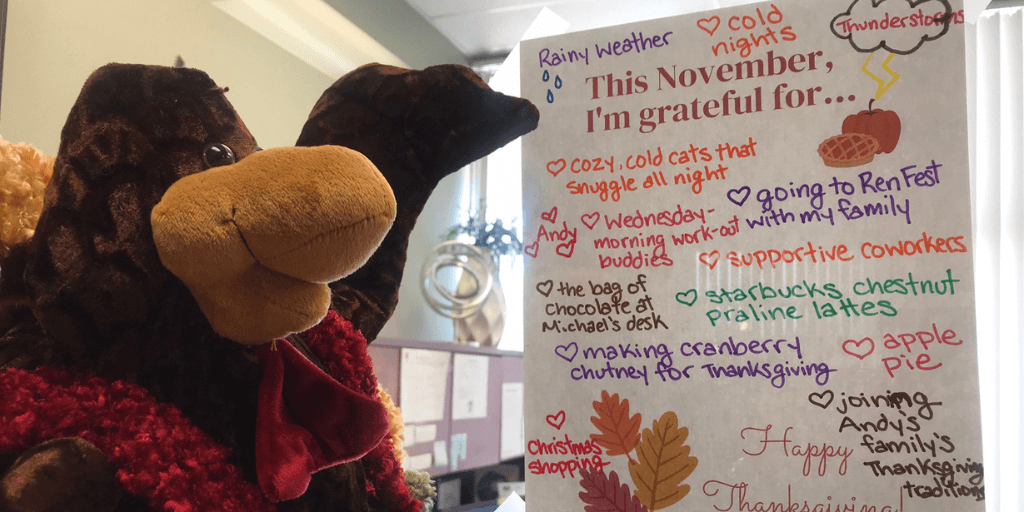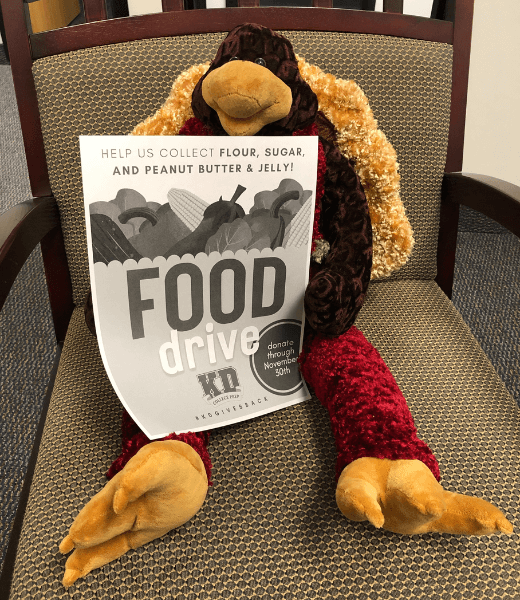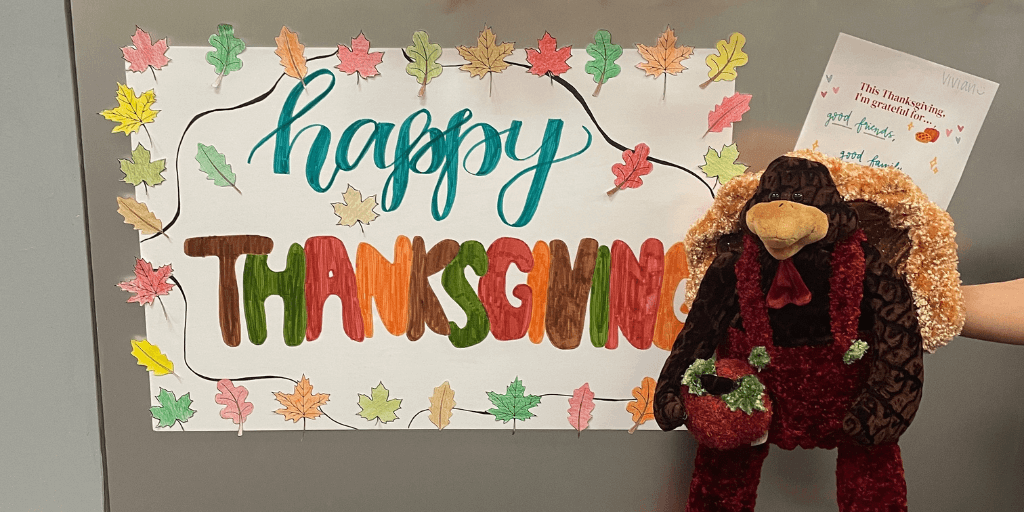Thanksgiving is a holiday where giving thanks is built right into the name. This time of year is all about gratitude for what we have and for what other people do for us. It’s about acknowledging that so much of what we have is only ours because of the support of many other people along the way.
We worked hard to get to where we are, but we can’t deny that we would have never gotten here without the friends who answered our panicked calls at 3 AM or the baristas who always had our cups of coffee ready to go on our ways into work. Even small acts of kindness and support added up and made it possible to grow into the people we are today.
And while focusing on gratitude during the holidays is great, the benefits of gratitude are too important to relegate to one time a year. The benefits of focusing on gratitude are more significant if you do it regularly—apparently once per week is the sweet spot.

Why Is Gratitude Important?
Our brains are fickle. A brain very quickly dismisses something, that was previously the best thing that had ever happened to you, as its new normal. But negative emotions are a bit like Hexxus from the movie “FernGully” (and sure, my analogy comes from 1992, but the imagery really stuck with me as a kid, so bear with me here). Hexxus is an oily, oozing poison that sticks to anything he touches, leaving a residue behind and polluting a vibrant forest. Negative emotions are like that for our brains—we could have an amazing day where a single bad thing happened, and what we tend to remember is the residue of that one bad thing.
Gratitude is so important because it can force your brain’s natural focus away from the bad and back to all of the good. To continue my “FernGully” analogy, think of gratitude like the magic Crysta, the forest-protecting fairy protagonist, wields against Hexxus in their final battle. She causes plants to sprout from his toxic form until his is ultimately imprisoned in a massive flowering tree. When we focus on gratitude and the good in our lives, even in the midst of truly difficult experiences, we can grow through the negative and surround it with so many positive thoughts that the negative becomes insignificant.
For thoughts on the importance of gratitude that don’t have anything to do with a 90s animated movie, I turned to KD College Prep CEO David Dillard:
“I have found in my long, well-lived life that ‘gratitude’ is the single most important influencer to my ‘attitude.’
A sense of gratitude reminds me that I live in a world surrounded by blessings. It helps me recognize the good in my life—good circumstances, good people, good possibilities for the future. It humbles me, making me aware of my place in the universe, as a creation of a greater power who cares and wants the best for me. It keeps me open for the wisdom and contributions of others added to my life daily.
Gratitude is the magic ingredient of a centered, peaceful life, a true gift from God, and a wonderful gift we can generously pass on to others.”
– David Dillard, CEO of KD College Prep
If you’ve ever had the opportunity to meet David Dillard, you’d know that he deeply believes this and lives his life according to it. He starts or ends every company meeting by expressing his gratitude for the hard work our staff puts in, for the experience our teachers bring to the classroom, for the trust our families place in us. His sense of gratitude is a mark of his management style, and later in this article we’ll explain why gratitude is an important leadership quality.
How Does Gratitude Impact Your Mental Health?
Outdated movie references and personal anecdotes aside, scientific research actually backs up the benefits of gratitude for physical, psychological, and social well-being. Research shows that practicing gratitude on a regular basis strongly correlates with lower anxiety and depression, stronger immune systems and lower blood pressure through the reduction of stress, and fewer feelings of loneliness or isolation.
The benefits of practicing gratitude have been primarily researched with emotionally healthy people who report non-clinical levels of depression or anxiety. But the idea that your thoughts affect your feelings, which affect your actions, which affect your thoughts, and so on, has been around in clinical psychology since at least the 1960s when Cognitive Behavioral Therapy (CBT) emerged. CBT’s primary goal is to challenge and reprogram cognitive distortions (or inaccurate and often negative patterns of thought and belief) to improve emotional regulation and coping strategies.
According to recent research conducted with people suffering from mental health issues, practicing gratitude—when coupled with psychological counseling—correlated strongly with “significantly better mental health,” even weeks after ceasing the gratitude exercises. And why wouldn’t it? What is practicing gratitude other that focusing your thoughts and beliefs into positive cognitive patterns?
Saju Abraham is a licensed professional counselor and owner of Abraham Coaching and Consulting. Before becoming a mental health professional, Saju worked as an advisor at KD College Prep and a teacher for Dallas ISD. Because of his expertise and unique background of working with students, we asked him about his thoughts on gratitude and mental health:
“I think there is certainly a direct correlation in regards to gratitude and emotional well-being. When you break emotional dysfunction down to its core, one of the elements you’ll find is dissatisfaction. It is unfortunately a self-focused perception which cripples our ability to see our own blessings as well as cripples our ability to see other people’s pain. We get trapped in the mindset of thinking our problems are much more severe than others when, in reality, this is very rarely the case.
At this level, our mind has a choice. We can choose to focus on 1) our blessings, 2) on our pain, 3) other people’s blessings, or 4) other people’s pain. The healthier we are, we are able to give each of these a healthy amount of proactive focus and attention. However, if we struggle, unfortunately we fixate on the one element that throws gratitude out the window which is a fixation on our own pain/problems.
Now to take this one step further, the more intensely we are struggling emotionally, we will combine the focus on our own problems with the focus on other people’s blessings. Now this certainly warps an individual’s perspective and unfortunately sets them up for extreme emotional failure.”
– Saju Abraham, LPC, Owner of Abraham Coaching and Consulting
While research suggests that gratitude can literally rewire your brain to respond in happier, healthier, less stressed ways in the long term, please know that practicing gratitude is not a substitute for seeking professional help from a psychiatrist, psychologist, or therapist/counselor if you are suffering from severe depression and/or anxiety or are considering self-harm, suicide, or harming others.
Why Should Teens Practice Gratitude?
Gratitude is important at any age, but it is especially important for teenagers for a couple reasons. Positive emotions, like gratitude, “open us up to more possibilities,” and, when we are open, we are more capable of learning and making good decisions. Research has also shown that “gratitude is an attainment associated with emotional maturity”—essentially, while adults derive positive benefits from practicing gratitude, children do not. Since learning from your mistakes and making good decisions are also marks of emotional maturity, it stands to reason that young adults, still in the midst of rapid growth and development both of their brains and of their core values, should start reinforcing positive psychological pathways.
I remember being 16 and badly wanting to be considered an adult by all the real adults around me. And while I’m still not sure that I qualify as a real adult all these years later, the primary difference I can identify between me then and me now is how I think about and respond to situations. Now, I am more open to constructive criticism and to learning a better way to do things. I make fewer decisions based on panic or emotion. I try to put other people’s needs first. Not that I always succeed at these—I don’t. But I’m conscious of the need to do them, and I do my best. And gratitude has a huge part in the times I’m successful. I’m grateful to have the opportunity to try again and to do better the next time. I’m grateful to have people in my life with more experience than me who I can ask for advice before making decisions. I’m grateful to have people whose needs I need to consider because it means I’m not alone.
For me, the learning curve between wanting to be an adult and thinking like an adult was steep. There were plenty of mistakes and a lot of painful lessons before I got to a place where gratitude could start to win in my thoughts. And I can’t help but wonder how much heartache I might have saved myself if I had started intentionally practicing gratitude at 16 and forged those positive thought processes from the beginning.
Does Gratitude Help You Become a Better Leader?
Gratitude definitely seems to help people become better leaders. A leader who is calmer, happier, and more positive due to the personal effects of practicing gratitude is already in a better emotional situation to handle unexpected stress or workday difficulties. But beyond being more personally ready to lead, a boss who can exude a sense of calm during a busy day is like a balm in the workplace—they can bring down the stress levels of all the employees around them because the situation always feels under control. Likewise, the boss feels approachable, like someone an employee could come to for advice or encouragement.
Gratitude also keeps you humble because you necessarily acknowledge all the people outside of yourself who made your success possible—the employees who all pulled 12-hour workdays right alongside you, the assistant who got you lunch and held your calls so your workflow wasn’t interrupted, or the janitorial staff that kindly skipped vacuuming your office the night you worked so late you accidentally fell asleep at your desk. When a leader expresses humility and gives credit where credit is due, it makes the people they lead more willing to make similar sacrifices for the success of the group in the future because they know their sacrifices will be noticed and appreciated.
How Can Students Show Gratitude?
There isn’t a right way to practice gratitude. It doesn’t matter if you do it when you wake up or when you go to bed. It doesn’t matter what method you choose. About the only thing that does seem to matter is the frequency. According to research, we see the most benefit from practicing gratitude about once or twice a week. When we start focusing on positive events too frequently, our brains adjust and seem to just filter it out. Practicing gratitude once a week or so forces our brains to pay close attention to positive things in our lives while still being a novelty that we don’t just acclimate to.
Write a Thank-You Note
I won’t lie—I still have a box full of handwritten notes passed to me in junior high and high school. The ones I treasure, though, are the ones where my friends thank me for being there for them, or listening, or simply being me. I’ve saved Christmas cards and birthday cards filled with gratitude for my existence too. Even when some of the people who wrote these notes and cards haven’t been in my life for 20 years, the sentiments still mean something to me. I also recently came across a note I must’ve received in high school from a secret admirer. And sure, a lot of it was silly and about how my hair caught the light in the hallway, but, years later, it still felt good to read that someone thought I was awesome enough to tell me about it.
Writing a thank-you note can definitely encourage your own feelings of gratitude as you think about everything you want to thank this person for, but it can also inspire feelings of gratitude in the recipient for years to come. So write an email, send a letter via snail-mail, or pass a note in the hallway.
Write to your best friend, so she’ll find it in a box 20 years later and send you a picture of the note you passed her in 7th grade. Write to your teacher, so he can pin it to the bulletin board behind his desk and read it after a difficult day of teaching. Write to someone who needs to hear it and send the letter anonymously, so that person will know someone out there thinks they’re awesome enough to tell them about it.

Show Your Appreciation for Someone
Showing your appreciation for someone can look like writing a letter, but it can also look like a lot of other things. The goal is really just to make someone feel special. You can bring your teacher or coworker their favorite coffee as a surprise. You could tell them in person how much they mean to you. Feel free to get creative here!
Don’t forget that self-appreciation is just as important as appreciating others. We are hard on ourselves—unjustly so—in ways we would never dream of judging or condemning our friends or even our enemies. One of the best ways to appreciate yourself is to stand in front of a mirror, look yourself in the eyes, and tell yourself I love you. Or, as one University of Utah writer puts it, “daily, practice saying five good things about yourself. It may be awkward or difficult at first, but over time it will become easier.”
Keep a Gratitude Journal
There are lots of ways to keep a gratitude journal. Base your method around what works best for you.
If you like structure and prompts for reflection, there are more products and resources out there than I can list, but I’ll give a few of my favorite examples. For the low-tech bibliophiles among you, check out the book The Five-Minute Journal or the quarterly magazine The Mindfulness Journal. And for the techies, look no further than your app store for apps like Daylio or Finch (on Finch, your journaling sends a cute little bird friend out to explore and report back—it’s absolutely adorable). While there are a lot of subscription-based journaling apps out there, and Daylio and Finch do have premium subscription versions, everything you really need to do on either app is totally free.
If freeform is more your thing and a blank page doesn’t scare you, then start a gratitude note on your phone or buy a Moleskin and write in it before bed. If you’re artistic, fill a sketchbook with drawings or paintings of what you’re grateful for. And if you’re the organized, bullet-journal type, make a gratitude list that you can add bullet points to each week.
Focusing on the positive emotions tied to gratitude is the important part of the exercise, not the medium, so try out several things and do what works. Or do what I do—a little of everything, depending on how I feel that day. I journal in my Finch app one day and write my thoughts down around a collage of magazine tidbits the next day, and I’m grateful I don’t have to choose between them (see what I did there?).
Count Your Blessings
Pick a time each week to sit down and list out your blessings—you can even decide in advance how many you want to list. Try writing the list each week on your bathroom mirror with dry erase markers and then saying the list to yourself each morning.
Alternately, write what you are grateful for on a slip of paper once a week, and try to pick a different thing each week. Put the slips of paper into a jar somewhere prominent in your house and watch the jar fill up throughout the year with visible reminders of how much you have to be grateful for.
Pray or Meditate
Whether you actively practice a religion, consider yourself spiritual, or are neither, there is value in prayer or meditation centered on what you have to be grateful for. Praying or meditating on gratitude connects you to the people and the universe around you, acknowledging how much of what you have is due to circumstances outside of yourself. Robert Emmons of Greater Good Magazine writes, “In many spiritual traditions, prayers of gratitude are considered to be the most powerful form of prayer, because through these prayers people recognize the ultimate source of all they are and all they will ever be.”
Give Back

From something as small as purchasing the cup of coffee for the next person in line, to giving money to a good cause, to volunteering your time and effort at a food pantry or with Habitat for Humanity, giving to others makes our own gratitude for what we were given all the more poignant.
For example, this month we’re running a food drive to help collect much-needed materials for Dallas-Fort Worth food banks.
Gratitude Activities for the Home or Classroom
Teachers can incorporate gratitude practice into the classroom using things like the thank-you letters or gratitude journals discussed above (or filling out “I’m thankful for…” pages like we did at each of our KD campuses), but there are also gratitude activities that are specific to groups.
Gratitude Secret Santa
Instead of drawing names for Christmas gifts, you could draw names, at any time of the year, to write each other notes about why we are grateful for the other person. Then leave the note somewhere the person will find (assigned seat, locker, etc.). You can even sign off the notes anonymously—”Sincerely, someone who’s grateful you exist” or “From someone who thinks you’re awesome.”
Group Art
You can work together to make a group collection of gratitude. Start by making the central display piece as a group, like a tree trunk or the stalk of a flower. Then have each student write what they are grateful for on something to add to the central piece (like a leaf or a petal). Once everyone has attached their part to the whole, you will have a beautiful depiction of gratitude.
Origami Lucky Stars
Start by getting a big glass jar and a bunch of colorful paper. Then have your students cut long, thin strips from the paper (roughly 11 inches long and ½ inch wide). Now comes the gratitude exercise—have each student write something they are grateful for on the strip of paper (write on the blank side if only one side has the color/pattern). Students should then follow the instructions here to fold their strip into a small pentagram that they can then puff up into a tiny star. Each student drops their star into the glass jar, and, if you do this once a week, your jar will be full of gratitude stars in no time.
Takeaways
From journaling to classroom activities, there are numerous ways for students to practice gratitude. In summary, a grateful heart can serve you well throughout life, by both improving your outlook on life and helping your build positive leadership qualities. So, the next time that you have a moment to pause and reflect, try focusing on the sprouts of joy and goodness that bring magic to your life and contribute to your personal growth. You won’t regret it.

Need Help Preparing for College?
If you would be grateful to have a team of experts to help you answer your questions about the college prep process, KD College Prep is here to help your family build a plan for test prep and the college admissions process. Since 1992, we’ve helped more than 76,000 students reach their test score and college admissions goals. Schedule your free consultation to talk to one of our advisors.














































